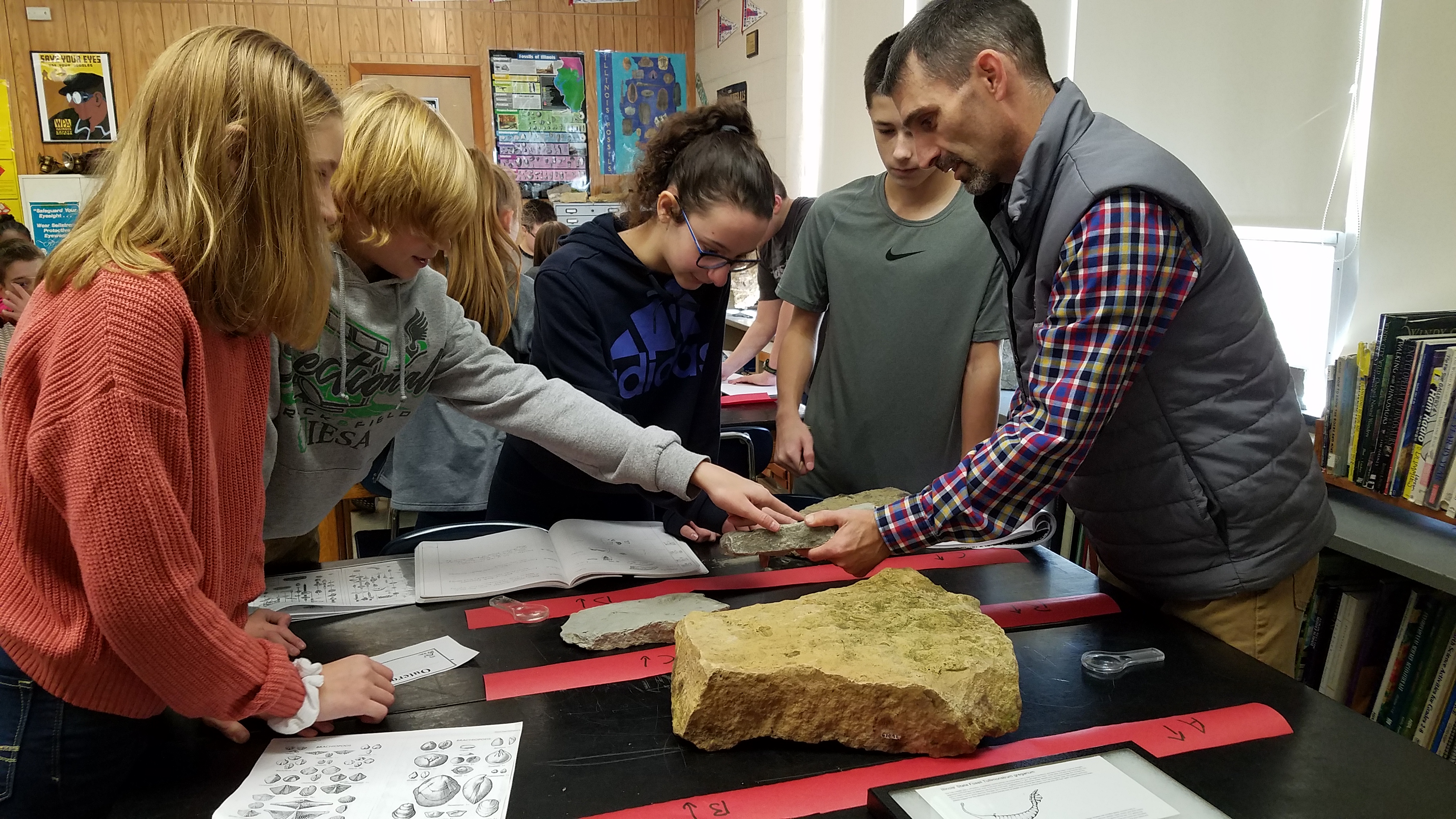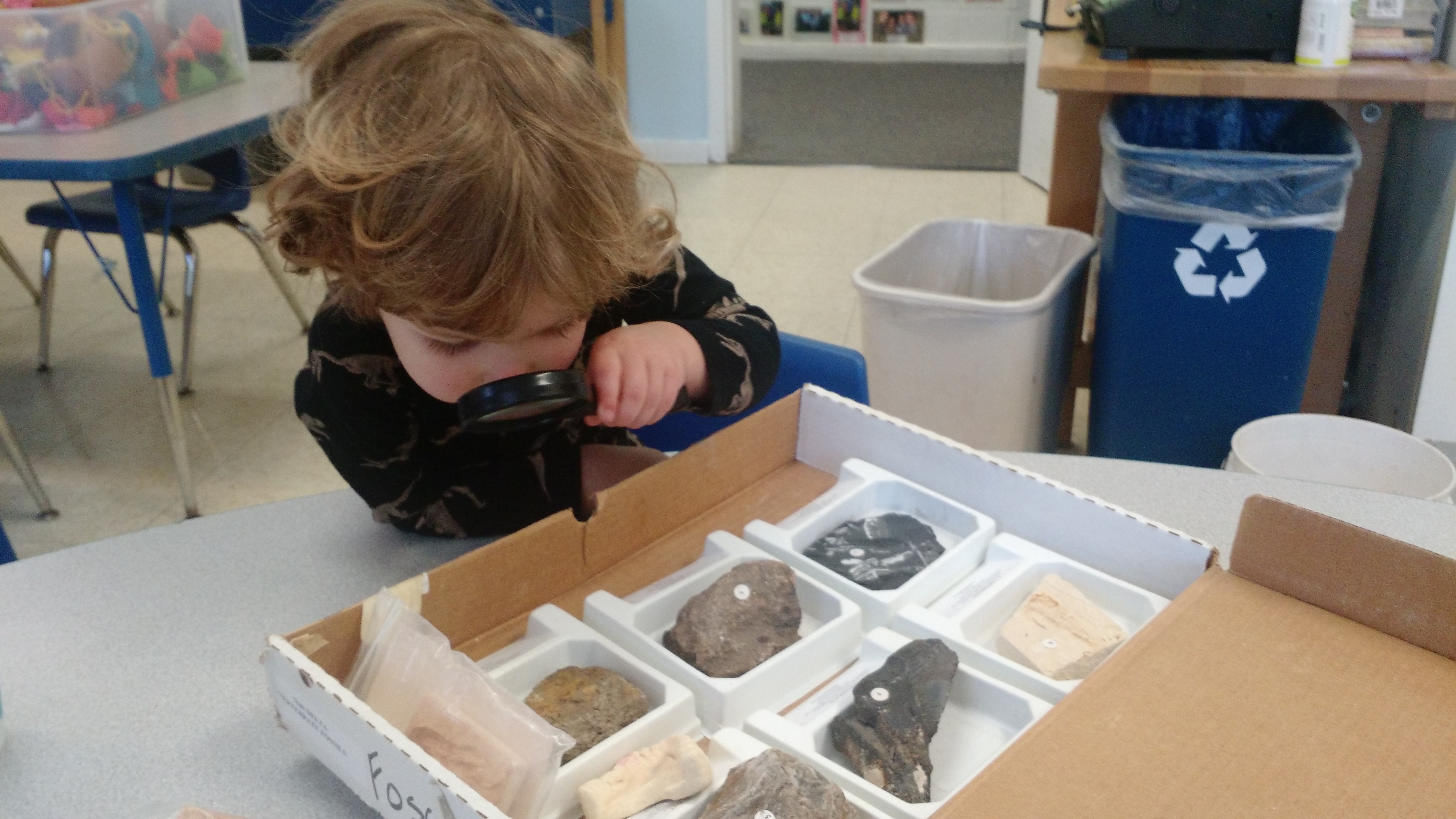Inspiring Young Geoscientists With Fossils
By Debra Shapiro
Posted on 2020-01-02

“I have an extensive fossil collection that we use in my eighth-grade science classes. We use it in our investigations of Earth history, in particular the Midwest,” reports Troy Simpson of Glenn Raymond School in Watseka, Illinois. He says he uses fossils “not only for investigating how life evolves and develops, but [also] for paleoenvironmental changes, simulated geologic strata interpretation, piecing together the geologic history of our region. I believe…getting the specimens in the hands of the students…helps make it more relevant to them…Even if you have [only] a few samples, it can impact students’ learning.
“I like to use larger specimens that show fossils in their environmental and geological context. This helps with the student interpretation of the geologic past,” Simpson observes. “The Midwest used to be an ocean and a tropical forest; we have evidence of this.
“My mission is [this]: We need more geoscientists,” Simpson asserts. “Unfortunately, geoscience [has] become a fossil science in and of itself. It is a vicious cycle [in which] fewer students are introduced to it at the K–12 level, thus fewer college students go into it, then numbers drop, and programs become downsized. Looking down the road, we will need those geoscientists to help with investigations on Earth and on other celestial bodies
as well.”
DeLacy Humbert, a science teacher at Capital High School in Helena, Montana, would agree. She acquired funding from science-based grants that allowed her to create a high school class on paleontology. “Everyone loves dinosaurs, but after third or fourth grade, [the enthusiasm] dies down. That’s a detriment to STEM [science, technology, engineering, and math because] dinosaurs are a ‘gateway science drug,’” she explains. “I saw the need. In paleontology units in Earth science class, the students loved it.”
Humbert says she “dreamed of this class for years. It took two years to get everything ready and propose it” to all of the department heads and the principal, then to the school board. She had to create her own curriculum and resources because “nothing between [the] elementary [level] and [the] college [level] existed.”
Humbert first taught the class in the 2018–2019 school year. “We had 30 students and a waiting list. There were a few less students this year, but we still had a waiting list,” she notes.
After the first year, Humbert tweaked the course. “Last year, we did a pigeon dissection before lunch. It was gross, and pigeons are expensive,” she admits. This year, she is using rotisserie chickens, which are much less expensive. “Bone structure is important,” she maintains.
Humbert also leads a summer camp that features a dinosaur dig. To prepare the students, she shared fossils from her collection and revealed their age, then had the students identify them. “It takes a while for them to identify [the fossils]. They need practice,” she contends.
The dig was challenging, she says, because “I have to teach [students] how to excavate and prospect. Prospecting is hard because the terrain isn’t easy. [There’s the] dangers of falls, snakes, and wild cows.” Students’ parents had to sign waivers and provide health insurance, she notes.
Last summer, she and her students found a couple of dinosaurs. “I teach them how to prepare the fossils so they will be able to do internships at university labs,” she reports.
Michael Baldwin, IB Biology and IB Chemistry teacher at Brent International School in the Philippines, has his students do several activities to learn about fossils. For one, he says, “I find diagrams of articulated fossil vertebrates from different time periods, project them onto a surface, and draw and cut out the bones on card stock as close to actual size as possible. I then mix the ‘bones’ in a plastic bag, and I have students try to reconstruct the animal. From their reconstruction, you can have them draw what they think the animal looked like; you can give them real index fossils along with their skeleton so that they have to try [to] identify when the animal lived. They can look for evidence of what the animal ate and how it moved, etc. You can also have students use similar puzzles to compare homologous structures, etc.”
In another activity, says Baldwin, “Students can look at photos of fossil leaves and count stomata to compare to living plants to investigate possible levels of carbon dioxide in a discussion of the effects of carbon dioxide concentration and global warming on plants. Is there evidence that there was a high level of carbon dioxide as indicated by the number of plant stomata on similar species of plants from the Eocine [epoch]?” He has also “had students do experiments to test different hypotheses about the function of gastroliths [rocks held inside a gastrointestinal tract] in plesiosaurs.”
Teaching about the fossil record and how it’s changed over time gives her eighth graders “a piece of evidence to show how species changed over time,” and helps them construct a scientific explanation using geological rock strata, says Tanya Gordon, Earth science teacher at West Junior High School in Boise, Idaho. “My colleague and I have students do an activity to address that as part of a quarter performance task.”
Sue Meggers, middle school science instructor at Interstate 35 School in Truro, Iowa, points out that fossils are not only evidence of life, but also “evidence of nutrients, especially in typical marine deposits (limestone, potash, and phosphorus are mined from marine deposits and used as nutrient supplements or pH balancers in soils). And there’s an economic connection to fossils; for example, limestone is used in building.”
All of the teachers agree that letting students do their own fossil identification is essential to three-dimensional learning. “I brief them first, then give them the resources to do it, but they have to figure it out,” Meggers maintains.
Even young children can benefit from exploring fossils, says Sarah Erdman, lead teacher at FB Meekins Cooperative Preschool in Vienna, Virginia, whose collection includes “some mud tracks, fossils plus the environment they’re in, which helps students connect with what fossils are.” She adds, “We’ve been lucky to have people bring in their personal collections—for example, a paleontologist who visited my class…With students this age, we expose them to what we learn [from fossils] and who does the finding, [which is someone’s] job. [We tell students,] ‘That’s so-and-so’s mom who also [finds and studies fossils].’” At age three, children become aware of gender roles, “so it’s great to counteract that [by saying,] ‘This is an everybody thing.’”

Finding, Handling, and Storing Fossils
Simpson connects with local quarry managers who help him find fossils. He also gets them from contacts from the National Earth Science Teachers Association and the Geological Society of America. And he takes his students to accessible outcrops and parks where collecting is permissible to gather rocks and fossils: “My students and I can go on-site and learn on the spot [about] the geology of the area and its fossils,” he relates.
In her rural area, “we live on Devonian to Pennsylvanian bedrock, so we collect fossils in our gravel,” reports Meggers. “My students don’t think of their environment as very cool or unique. Then they discover that their driveway has fossils. It blows their minds!”
“I was very fortunate to receive some lovely fossils from a member of our local rock club,” says Marteen Nolan, science teacher at Crocker High School in Crocker, Missouri. Among them was a fossil bed that intrigued students in her advanced geology class, so they contacted a University of Missouri-Columbia geology professor for assistance in identifying the fossils. “The students were able to determine that what they had thought was a [dinosaur] bone was in fact a different type of mud, and the fossil bed was likely from an ancient oyster bed that had been washed inland by a hurricane. It was such a great authentic scientific inquiry experience for them,” Nolan relates.
“Our state mining trade industry does a summer workshop,” she notes. “If mining takes place in your state, check with a mining agency” about fossil donations, she advises. Nolan also offers some safety precautions: “Obsidian glass is a volcanic glass with sharp edges…Don’t bring in asbestos! Gypsum can have it, too, so don’t let students hold it.”
One consideration for teachers is fossil storage. “Storage depends on how rare the fossil is and its condition. Some fossils can only be looked at. Thing is though, if you use them, then eventually they may be broken,” Baldwin cautions.
“I’m encouraging students to touch all of the fossils except carbon films because they’re so fragile,” says Gordon, who has found carbon films with impressions of fish fossils. She suggests that experienced teachers share their fossil collections with new teachers. “It would be beneficial for new teachers to have a way to build a collection…Foster that new enthusiasm for teaching with the ability to share things hands-on with students.”
This article originally appeared in the January 2020 issue of NSTA Reports, the member newspaper of the National Science Teaching Association. Each month, NSTA members receive NSTA Reports, featuring news on science education, the association, and more. Not a member? Learn how NSTA can help you become the best teacher of science you can be.
Disclaimer: The views expressed in this blog post are those of the author(s) and do not necessarily reflect the official position of the National Science Teaching Association (NSTA).


